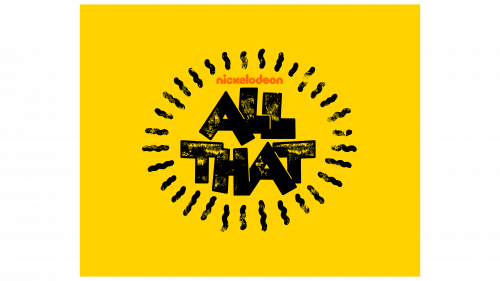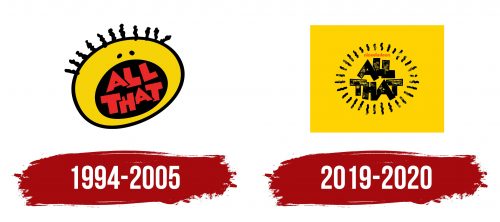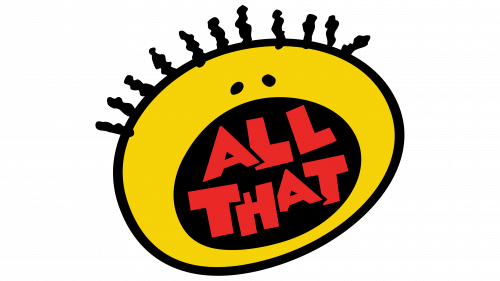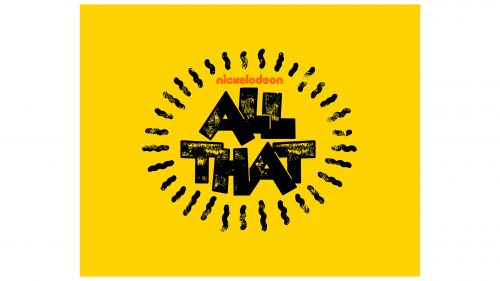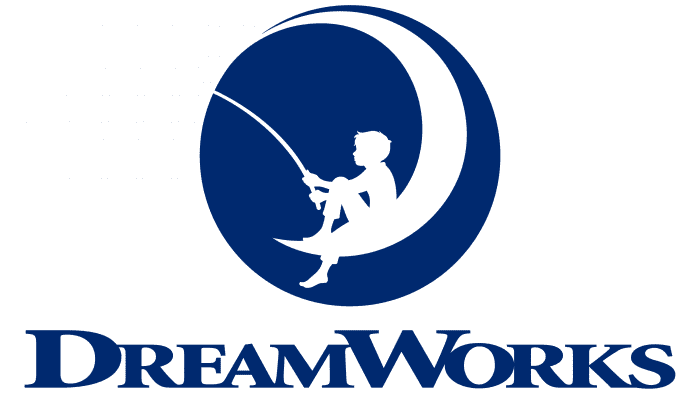The All That logo is full of fun and friendliness, embodying the atmosphere of relaxed communication among close friends. The symbols create a sense of warmth and openness as if inviting lively conversations on various topics. The emblem conveys ease and comfort, encouraging candid discussions where one can freely express their thoughts, share feelings, and enjoy the moment.
All That: Brand overview
The journey of All That began in 1993 when producer Brian Robbins and his partner Mike Tollin developed a new comedy series for children and teens. They aimed to create a show similar to Saturday Night Live but tailored to a younger audience for Nickelodeon.
The idea originated from the success of adult sketch comedies, with the creators adapting that format for kids. Robbins and Tollin conducted a thorough casting process to find young comedic talent who could bring the show to life.
The series premiered on Nickelodeon on April 16, 1994. The original cast included young performers like Josh Server, Kel Mitchell, Lori Beth Denberg, Kenan Thompson, and Angelique Bates. These young actors quickly won over audiences with their sharp, witty personas.
The first season was a major success. It appealed to a wide audience by combining musical performances, comedic sketches, and celebrity guest appearances. Segments like Kel Mitchell’s Good Burger became cult favorites among viewers.
Following its initial success, the show was quickly renewed for more seasons. As it evolved, new cast members like Amanda Bynes were introduced in the second season, and she became one of the most popular members of the ensemble.
By the third season in 1996, the series had firmly established itself as a Nickelodeon hit. It entertained fans and launched the careers of young talents like Kenan Thompson and Amanda Bynes, who later became major figures in Hollywood.
In 1997, the show’s success led to its first spin-off, Kenan & Kel, starring Kenan Thompson and Kel Mitchell. The spin-off became another hit, further solidifying the series’ reputation as a platform for rising stars.
By 1999, after five successful seasons, the cast underwent significant changes, with many original members leaving to make way for younger actors. Despite these shifts, the show remained popular and attracted new fans.
2000, the series celebrated its 100th episode, a rare milestone for a children’s show. That same year, the Good Burger sketch was turned into a feature-length film, which became a box office hit and reinforced the show’s cultural influence.
However, viewership began to decline by 2001. Nickelodeon attempted to revive the program in 2002 with an all-new cast, injecting fresh energy into the show. Despite the effort, the series aired its final episode in 2005 after a successful ten-season run. It became one of Nickelodeon’s longest-running shows and left a lasting impact on children’s television.
Even after its original run, the show’s influence continued. Many cast members had successful careers, most notably Kenan Thompson, who became the longest-serving cast member on Saturday Night Live.
In 2019, Nickelodeon announced that the beloved show would return nearly 15 years after the original series ended. Kenan Thompson and Brian Robbins, by then the president of Nickelodeon, served as executive producers of the reboot.
The revival premiered on June 15, 2019, maintaining the spirit of the original while modernizing it for a new generation. The new version featured appearances from original cast members alongside fresh talent. Critics and audiences praised the revival for blending nostalgia with contemporary humor. Production continued until 2020, when it halted due to global events.
Although no new episodes are being produced, the classic series remains popular in 2023. Its original episodes are available on streaming platforms, allowing a new generation to enjoy the iconic show.
The program made a lasting impact on children’s television history. It provided a platform for many talented actors and comedians to begin their careers, demonstrating that comedy for kids could be smart, inclusive, and appeal to a broad audience. The show also influenced the format of children’s sketch comedies that followed.
Nearly thirty years after its debut, the series has become a beloved cultural phenomenon cherished by multiple generations. Its influence on comedy and children’s television continues to inspire creators today.
Meaning and History
What is All That?
This is an innovative sketch comedy show for a youth audience on Nickelodeon, featuring a diverse cast of talented young and adult actors performing comedic sketches, parodies, and recurring roles. The program stood out for skillfully blending complex pop culture references with humor accessible to children, creating a series that appealed to viewers of all ages. Many young actors who started their careers on this show later became prominent figures in the entertainment industry. The sketch comedy on this show included funny parodies, slapstick, and clever wordplay, making the program unique in children’s television.
1994 – 2005
The show’s logo includes an image of a child smiley, emphasizing its focus on a young audience. The main participants of the program are children and teenagers, which is reflected in the logo itself. The baby’s wide-open mouth symbolizes lively communication and creativity — the show’s title is placed inside it. This element hints at the conversations, songs, and comedic performances that form the foundation of each episode. The participants joke and entertain the viewers, bringing smiles and laughter. The red logo highlights successful skits and relevant and interesting topics. The emblem was used for the show’s original version on Nickelodeon, further emphasizing its significance in the context of children’s content.
2019 – 2020
2019, it was announced that the show would return, and the new emblem underwent changes, reflecting the maturing of the show and its participants, who grew up with the project. The logo acquired a more mature look but retained its energy. The show’s bright yellow title symbolizes joy, fun, and laughter. This color creates a positive aura, highlighting the carefree atmosphere of the show. The black letters are slightly worn, as if covered in sand or accidentally splattered with paint, adding a light and informal effect, as though the viewers are being shown a behind-the-scenes glimpse, especially during the cold open. The lettering looks like a rough sketch, symbolizing spontaneity and simplicity.
The symbols are arranged to resemble a rounded figure, hinting at friendship and communication. This arrangement gives the impression that the logo gathers everything of interest to the young audience. The title is surrounded by black wavy lines, which can have several meanings:
- Sun rays symbolize energy.
- Sound waves represent active communication.
- The image of a scent enhances the perception of emotions.
- A circle of friends united by an idea.
The emblem perfectly conveys the spirit of unity and togetherness, highlighting the show’s key aspects that attract viewers.
